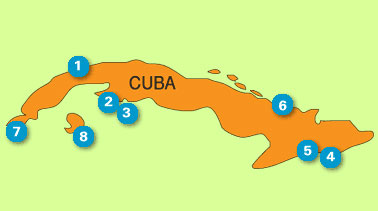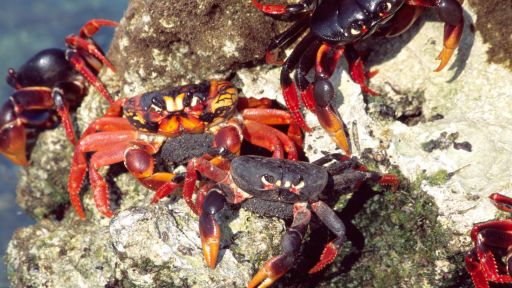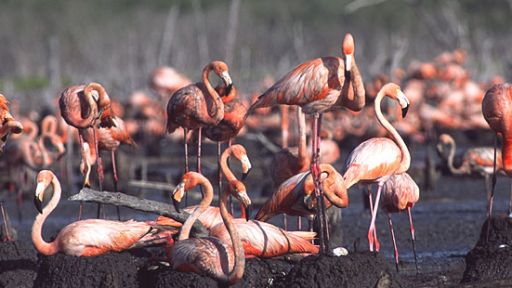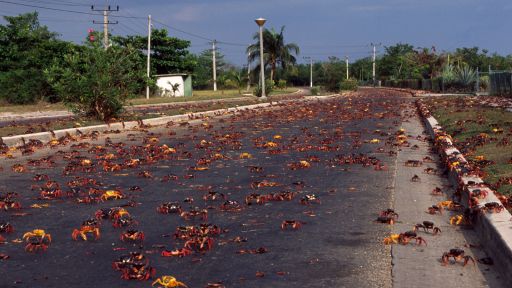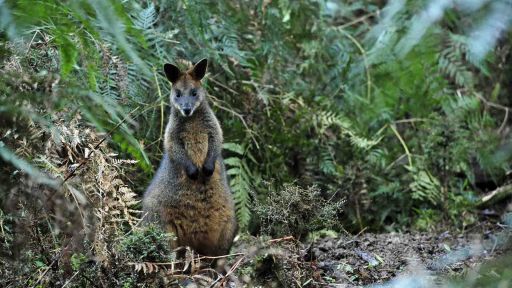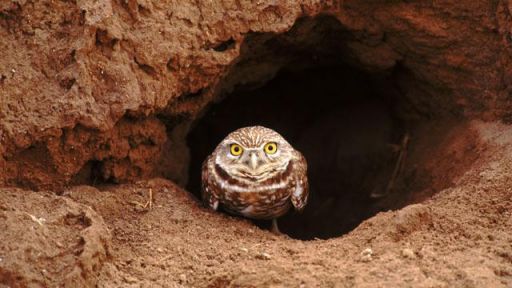
Ninety miles off the tip of Florida lies a Caribbean isle shaped like a crocodile. That’s fitting, because the island of Cuba is home to rare “leaping” crocodiles — and a host of other unusual animals, including some of the world’s smallest hummingbirds, frogs, and lizards. There are caves full of bats and their wily predators, snakes.
The Republic of Cuba is comprised of Cuba, the main island; four archipelagos — the Sabana-Camagüey, the Colorados, the Jardines de la Reina, and the Canarreos; and smaller islands. The republic covers more than 110,000 square kilometers, about the size of Virginia.
Cuba includes a patchwork of habitats, from fields and swamps to mountains and forests. Millions of tourists visit each year to swim in its warm seas and lounge on tropical beaches.
Here are few key spots for wildlife lovers:
Habana Province (1) is home to Cuba’s capital city, Havana, and lots of limestone caves and caverns. Some are flooded, drawing divers looking for adventure. Drifting in the perpetually dark waters, they can see a rare cave fish named Lucifuga, “the animal that flees from light.” It has no eyes and virtually no color, making it a ghostlike creature. Some species found in Cuba are found nowhere else. (More about Cuba’s wildlife »)
About 100 miles south of Havana is Ciénaga de Zapata (2) or Zapata Swamp, a world-famous wetland and national park. Mangroves, marshes, and woodlands there are home to a wide variety of birds, including two found nowhere else: the Zapata wren and the Zapata rail. The largest population of endangered Cuban crocodiles, known for their leaping abilities, also lives in the swamp. These crocs can grow to nearly 13 feet in length and 300 pounds in weight.
The Ciénaga de Zapata Biosphere Reserve, at 1.5 million acres, is Cuba’s largest protected area. But parts of the swamp are still unprotected. Nearby is the Bay of Pigs (3), where each spring millions of land crabs pour out of nearby swamps and into the shallow waters to breed. The bay was the site of a failed invasion attempt in 1961 by U.S.-backed Cuban expatriates intent on overthrowing Castro.
On the east end of the island, Guantanamo Bay (4) is a great place to see several dozen species of seabirds that feed in Cuban waters, from pelicans to sharp-beaked terns. The bee hummingbird, the world’s smallest bird, inhabits nearby forests.
At the Baconao Biosphere Reserve (5) there are caves full of bats, and the bat-eating cave boa. Visitors wait until dusk to watch the bats emerge for their nightly hunt.
A flock of a different kind — flamingos — can be found at Humedal Río Máximo-Cagüey (6), an internationally important wetland. Up to 75,000 of the tall pink birds can be seen feeding in the flats here, making it the largest colony of Caribbean flamingos.
At Peninsula de Guanahacabibes (7), on the very western tip of Cuba, a reef-fringed bay is home to sea turtles and the occasional porpoise. The reef is also visited by sharks and goliath groupers, which can weigh up to 800 pounds.
On the Isle of Youth (8) swimmers can see another kind of underwater treasure: coral reefs. These fence-like structures, built by living coral polyps, are home to an amazing array of brightly colored fish, clams, and invertebrates.
LAND & PEOPLE
Some say “Cuba” means “land” in an ancient Caribbean language. The island of Cuba, the largest island in the Caribbean and the 16th largest in the world, stretches for more than 740 miles across and more than 120 miles wide. It has about 1,500 miles of coastline, and no point on the island is more than 50 miles from the sea.
More than 11 million people call Cuba home. Most live in the low coastal plain that rings the island, where they raise sugarcane and other crops and work in small enterprises. The capital city, Havana, has a population of about 2 million.
Cuba has several steep mountain ranges. In 1959, communist leader Fidel Castro took control of the island, establishing a socialist dictatorship. The United States imposed a trade ban in the early 1960s, and limits travel to Cuba (other countries do not). The Soviet Union heavily subsidized Cuba’s economy until the end of the Cold War in the 1990s. Since then, the island’s economy has been slow to recover.
Cuba is composed mostly of limestone, a soft, porous rock that easily erodes. As a result, the island is honeycombed with caves and has the highest density of caves of any place on earth. There are also steep mountain ranges: the Sierra de los Órganos, the Sierra de Trinidad, and the Sierra Maestras. The Sierra de los Órganos are made up of “mogotes,” a set of oddly dome-shaped mountains. Pico Turquino, part of the Sierra Maestras, is Cuba’s tallest peak, rising up south of the Guantanamo Valley to about 6,500 feet.
Cuba’s tropical climate is moderated by trade winds, and includes a dry season (November to April) and a rainy season (May to October). Hurricanes periodically batter the island in the summer and fall.
UNIQUE PLANTLIFE
Cuba has more than 6,000 plant species, about half of which are found nowhere else. Some of the island’s best-known plants include the royal palm (Reistonea regia), which appears on the nation’s coat of arms. Some researchers believe there are more than 15 million palms on the island. Other interesting varieties include the rare cork palm (Microcycas calocoma), which is endemic and first appeared when dinosaurs walked the earth, and the big belly palm (Palma barrigona), whose shape matches its name.
Cuba’s swamps are renowned for their wide variety of plant and animal species. In the mountains, dry forests support a wealth of species, including delicate orchids and the elegant butterfly lily (Hedychium coronarium Koenig), the national flower. Mogotes, dome-shaped mounds in the Sierra de los Órganos, have a type of dry forest consisting of semidecidous and evergreen trees. The endemic ceibón tree (Bombacopsis cubensis) and piñón tree (Erythrina cubensis), and the oak tree (Tabebuia calcicola), are just some of the species found there. Pine forests, dominated by the Caribbean pine tree (Pinus caribaea), are abundant in the Sierra de los Órganos and in the northern half of the Isle of Youth. Rainforests also thrive in Cuba, especially in the eastern part of the island.
Along the southern coast, large mangrove swamps provide nursery waters for fish and important habitat for birds. The Zapata Swamp, the largest wetland in Cuba, has a wide range of vegetation, ranging from aquatic plants to plants typically found in semideserts. Species in the swamp include: water hyacinths (Ichhornia crassipes), fragrant water lilies (Nymphaea odorata), water lettuce (Pistis stratiotes), sawgrass (Claudium jamaicense), and sugarcane plume grass (Erianthus giganteus).
ECO-ALERT
Closed to much of the world for years, Cuba is now welcoming outsiders. Along with the tourists, however, has come development and increased use of natural resources. As a result, as on many small islands with a growing population, Cuba’s environment is feeling the pressure.
The government has stepped up efforts to protect Cuba’s environment. The problems are familiar. Deforestation and erosion are spreading as farms and cities expand. As trade improves, non-native species are finding their way onto the island. In addition, water pollution is worsening in Havana Bay.
Luckily, much of Cuba’s coastline and many mountain areas are still in very good shape, and the government is moving to protect them before irreversible changes occur. Over the last few decades, it has designated several major parks and stepped up efforts to inventory and map everything from dry forests to coral reefs. It has also moved to protect more than a dozen wetlands considered to be internationally important. International environmental groups have been helping out in an effort to prevent Cuba from repeating the haphazard development that has spoiled other Caribbean islands.
Many conservationists are optimistic about saving this remarkable wild island. But it may be decades before Cubans know if their efforts to preserve their natural resources for the future have paid off.
CORRECTION (January 7, 2015): This article originally stated that the land area of Cuba covers roughly 110,000 square miles. The correct figure is 110, 000 square kilometers.

